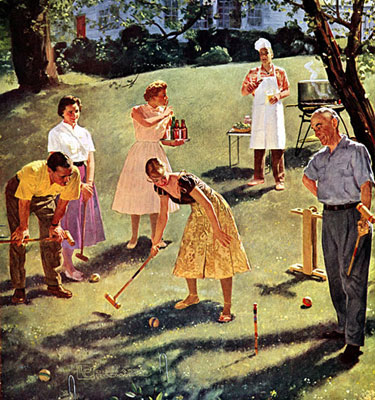 "Hey, come over here, kid, learn something. You never know, you might have to cook for twenty guys someday. You see, you start out with a little bit of oil. Then you fry some garlic. Then you throw in some tomatoes, tomato paste, you fry it; ya make sure it doesn't stick. You get it to a boil; you shove in all your sausage and your meatballs; heh?... And a little bit o' wine. An' a little bit o' sugar, and that's my trick." - Clemenza teaching Michael to cook. The Godfather, Part I.
"Hey, come over here, kid, learn something. You never know, you might have to cook for twenty guys someday. You see, you start out with a little bit of oil. Then you fry some garlic. Then you throw in some tomatoes, tomato paste, you fry it; ya make sure it doesn't stick. You get it to a boil; you shove in all your sausage and your meatballs; heh?... And a little bit o' wine. An' a little bit o' sugar, and that's my trick." - Clemenza teaching Michael to cook. The Godfather, Part I.
When Jeff and I were dating, we would on occasion deliver papers for his family’s Sunday morning paper route. I distinctly remember his mother’s detailed descriptions of whose paper went where: Mr. Lisi, the front door, Ms. Vitale, the side door, the Di Fusco’s, the front door if the screen was open but the back if it was locked. I also distinctly remember the smell that hit you when you walked up each of the little driveways early in the morning and opened the screen doors. Not coffee, not maple syrup, not bacon and eggs, but gravy.

 First off, I need to explain going bowling in France was never on my wish list, top or bottom.
First off, I need to explain going bowling in France was never on my wish list, top or bottom. As with so many foods in our lives, dishes served when we are young put strong imprints on our adult palates. Most nights when my father came home from work, he would settle into his leather recliner and watch wrestling on TV. While my sister and I set the table, my mother would serve him an appetizer plate and his cocktail of choice, a 7&7 (Seagrams & 7-Up).
As with so many foods in our lives, dishes served when we are young put strong imprints on our adult palates. Most nights when my father came home from work, he would settle into his leather recliner and watch wrestling on TV. While my sister and I set the table, my mother would serve him an appetizer plate and his cocktail of choice, a 7&7 (Seagrams & 7-Up). The happy childhood goes like this: My mother unwraps the silver boxes
of cream cheese as if they are presents. She beats the soft cheese –
the crack of eggs, a dust-storm of sugar – into pale snowbanks in the
bowl while she lets me crush the graham crackers with a hammer. I sneak
a few butter-laced crumbs and, later, watch the cooling cheesecake with
that wistful ache children can have about certain foods. Such moments,
repeated through the years, transform simple favorites into profound
emblems.
The happy childhood goes like this: My mother unwraps the silver boxes
of cream cheese as if they are presents. She beats the soft cheese –
the crack of eggs, a dust-storm of sugar – into pale snowbanks in the
bowl while she lets me crush the graham crackers with a hammer. I sneak
a few butter-laced crumbs and, later, watch the cooling cheesecake with
that wistful ache children can have about certain foods. Such moments,
repeated through the years, transform simple favorites into profound
emblems.
 Yesterday morning, I stood at the entranceway to our living room and surveyed the damage. There were stacks of books and magazines on the coffee table, tumbles of blankets on the couch, a smattering of empty mugs with used tea bag strings dangling over their rims. My abandoned crutches were leaning on the door, my physical therapy CPM machine on the floor.
Yesterday morning, I stood at the entranceway to our living room and surveyed the damage. There were stacks of books and magazines on the coffee table, tumbles of blankets on the couch, a smattering of empty mugs with used tea bag strings dangling over their rims. My abandoned crutches were leaning on the door, my physical therapy CPM machine on the floor. 
